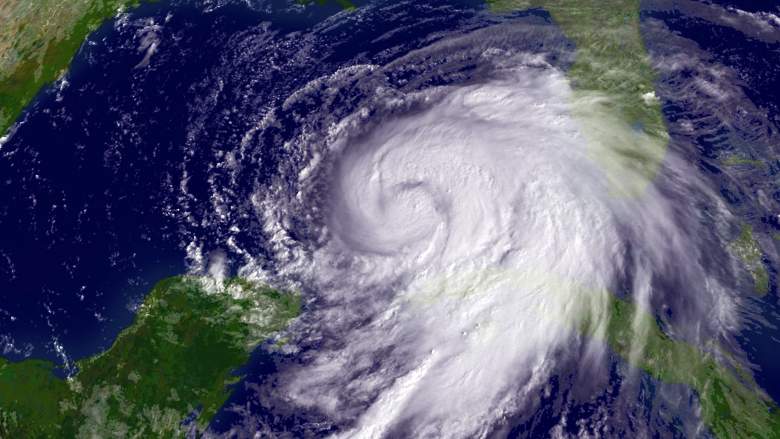
Getty Hurricane Ike on September 10, 2008.
Now that Hurricane Harvey has made landfall in Southeast Texas, it’s a good idea to look at the lessons of the last hurricane to hit the area, Hurricane Ike. After wreaking havoc in the Caribbean and Cuba, the storm made landfall in Texas on September 12, 2008 at 2:10 a.m. CDT.
Ike was responsible for an estimated 74 deaths, along with causing $37.6 billion worth of damage. That made it the third-costliest Atlantic Hurricane ever, behind only Hurricanes Katrina and Sandy. In December 2008, FEMA published a 60-page report on the storm’s impacts.
“In less than 60 days during the summer, Texas was assaulted by Hurricanes Dolly, Gustav, Ike and Tropical Storm Eduardo,” Jack Colley, the late head of emergency management for the Texas Department of Public Safety, wrote. “Of these, Hurricane Ike will likely go down in history as the most costly and destructive storm ever to hit Texas.”
Here’s what you need to know about Ike.
1. Ike Made Landfall Near Galveston as a Category 2 Hurricane With a 15-foot Storm Surge

GettyA damaged home in Kemah, Texas on September 16, 2008.
As The Weather Channel notes, Ike made landfall as a category 2 hurricane near Galveston Texas. It was the first hurricane to make landfall in Texas since Dolly in July 2008. It was also the third to make landfall over the Lone Star State this century. While Hurricane Rita did hit the upper Texas coast, it officially made landfall in Louisiana in 2005.
The Saffir-Simpson Hurricane Scale defines a Category 2 hurricane as one with winds between 96-110 mph and a storm surge six to eight feet above normal. Harvey is expected to make landflall as a Category 3, meaning its windspeed could reach up to 130 mph, with a storm surge nine to 12 feet above normal.
However, as Hurricane Science notes, Ike’s storm surge was far above normal for a Category 2. Its 15-foot storm surge was equivalent to a Category 5 storm. Hurricane-force winds were felt for 120 miles from its center. Unsurprisingly, Ike was the most powerful storm of the 2008 Atlantic hurricane season.
2. Ike Was Directly or Indirectly Responsible for at Least 74 Deaths in Texas
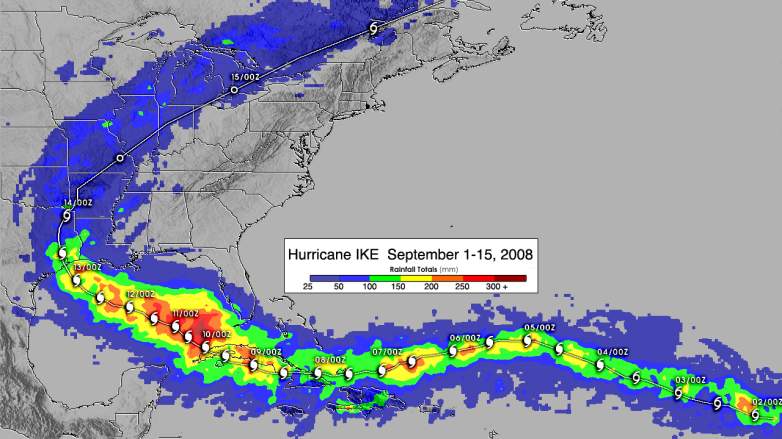
SSAI/NASA, Hal PierceHurricane Ike’s rainfall and path.
Ike was directly or indirectly responsible for at least 74 deaths in Texas alone, notes a 2011 Texas Department of State Health Services report. Deaths happened in 16 counties, with the most in Harris and Galveston. Forty-seven of the deaths were from injuries, 23 from illnesses and four were undetermined. However, other estimates put the total number of deaths in Texas at 84.
In total, Ike was responsible for at least 195 deaths. Seven people were killed in Cuba and 113 people were killed in the U.S.
As The Guardian reported in November 2008, Ike was part of a devastating hurricane season for Haiti. An estimated 800 people died that summer from four tropical storms, including Ike.
3. Bolivar Peninsula Was Among the Worst-Hit Areas, as Hundreds Refused to Leave Their Homes
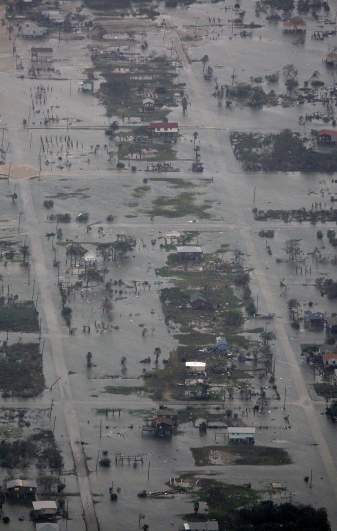
GettyAn aerial view of Bolivar Peninsula after Hurricane Ike.
The island of Bolivar Peninsula was among the hardest-hit areas. As Hurricane Ike points out, the island was hit with 12 to 16 feet of water, with a storm surge over the island’s elevation.
Some people refused to leave the island. As Associated Press report from before Ike made landfall notes that around 250 people refused to leave and the Texas attorney general’s office was even considering legal options to force people off the island. Authorities were ready to do what they needed to do make people go to a safer place.
Ike left Bolivar Penninsula completely changed. The storm surge wiped away an estimated 62 percent of the island’s structures were severely damaged. In 2013, The Houston Chronicle reported that at least 15 people were killed. Some people didn’t return and those who live on the island now are different from the pre-Ike population.
“It’s a different group of people,” Bonnie Pyle of Crystal Beach told the Houston Chronicle. “If I was to go to a bar right now I wouldn’t know anybody.”
At the time, the Chronicle reported that expensive homes were expected to rebuild the island’s population by 2016. In 2009, the average price of a home on the island was $152,000. In 2012, it jumped to $245,000.
4. Hurricane Ike Caused Almost $30 Billion in Damage in Texas & Could Have Been Much Worse
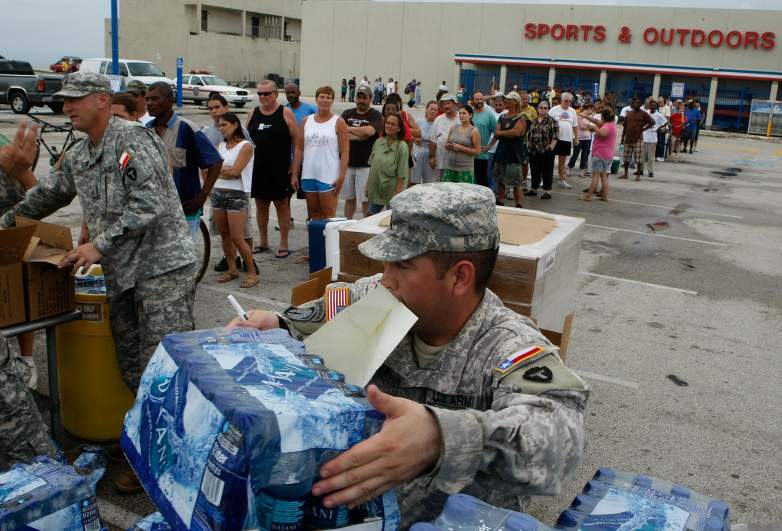
GettyTexas National Guard members help Galveston residents the day after Ike made landfall.
Estimates of the total damage cost caused by Hurricane Ike in Texas ranges from $25 billion to nearly $30 billion. However, it could have been much worse if it was a direct hit in the Galveston/Houston area, according to a 2010 Rice University study.
“If Hurricane Ike had hit 30 to 50 miles down the coast, the devastation would have been remarkable; the cost could easily have exceeded $100 billion and hundreds might have died, as was the case with Katrina,” Dr. Philip B. Bedienet and Jim Blackburn wrote in the 2010 study.
Ike had a long-term impact on the area’s economy. For example, The Christian Science Monitor reported in December 2008 that the University of Texas Medical Branch, the largest employer in Galveston, was cutting 3,800 jobs. The storm caused $710 million in damages to the hospital. And even though Galveston was under mandatory evacuation, NPR reported that at least 40 percent of residents didn’t follow the order.
A Texas state report estimated that the storm caused $3.4 billion in housing damage, with 61 percent of flooding damages uninsured.
5. The Proposed ‘Ike Dike’ to Prevent This Kind of Destruction Again Still Hasn’t Been Built
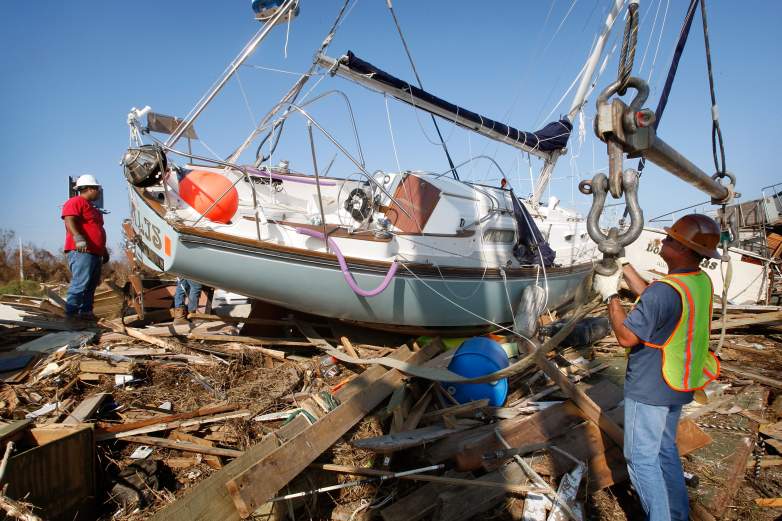
GettyGalveston residents were allowed to return to their homes until September 24, 2008. This photo was taken on September 21, 2008.
In 2009, there was a proposal to build a so-called “Ike Dike” to protect the upper Texas coast, up to the border with Louisiana. According to ABC13, the toughest and most expensive part of the plan includes a 1,200-foot-wide storm gate across Galveston Bay. Since the bay is much wider, there would be levees at the gate in the middle. It would be similar to a gate in The Netherlands that’s been working since 1997.
In 2014, Texas agreed to fund a report, which is finally expected to be released this fall. It is estimated that the plan, which would help six counties, could cost $12 billion.
“The storm surge protection plan is very much still alive,” Galveston County Judge Mark Henry, who is leading the group behind the study, told ABC13. “I am confident that someday something will get built. Unfortunately, we are a reactionary society at times – especially the government – and I fear it will take another disaster such as New Orleans for people to say we’ve had the plan on the shelf for a while. Let’s fund it and get it built.”
As The Houston Chronicle notes, Texas General Land Office Commissioner George P. Bush wrote a letter to President Donald Trump, urging him to protect the area because it is the top supplier of energy products from the U.S. military. Bush, a member of the Bush political family, wrote that it is “crucial to national security.”



